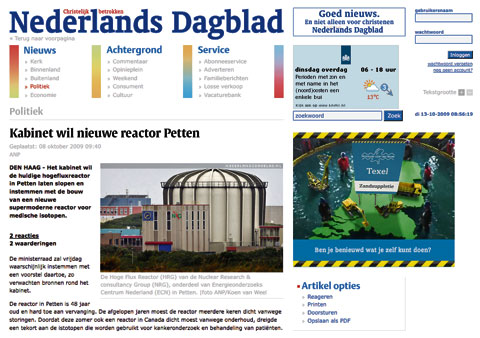Last Friday, the Dutch cabinet-council supported a proposal to demolish the 48-year old reactor in Petten and to have a new one built.
The Netherlands needs a new nuclear reactor for the production of radioisotopes for medical applications. It’s the latest in a series of headlines concerning the issue. The latest, but by no means the last. The production of the radioisotopes has been a troublesome affair for years, owing largely to the frequent technical failures of the only five or six over-aged reactors that provide the isotopes worldwide. The reactor in Petten, exploited by NRG (Nuclear Research & consultancy Group), and the Chalk River reactor in Canada, are the main providers of molybdenum-99, on which cancer patients rely. Molybdenum-99 is the precursor of the meta-stabile isotope technetium-99m, widely used as a marker in nuclear medicine for diagnosing cancer and bone, heart or kidney problems.
Professor Bert Wolterbeek, of the faculty of Applied Sciences’ Reactor Institute Delft (RID), welcomes the cabinet-council’s decision. In his opinion, the required 300 million euro for a new high flux reactor will be money well spent, considering that NRG accounts for about 40 percent of world production in 99m-Tc generators and that the new reactor has an expected lifespan of 30-40 years. Besides, Wolterbeek says, there is no real alternative for the production of these radioisotopes, except for the so-called high flux reactors (HFR). HFRs generate relatively little heat, but a large flux of neutrons. Reactors for power production are focused on the opposite: large heat production. An HFR’s large neutron flux is used to produce molybdenum-99 from uranium or from molybdenum-98.
Wolterbeek refers to an article in a recent issue of the Dutch technology magazine, De Ingenieur, which explored alternative routes for radioisotope production. Some argued that particle accelerators might also be used to create molybdenum-99. Wolterbeek doesn’t regard that as a credible production route. The reaction might work in a laboratory but no steps have been taken to scale it up to industrial production, which, in Wolterbeek’s eyes, discredits the use of accelerators as a production technique. He has patented an alternative pathway to molybdenum-99 production, which takes molybdenum-98 as a source instead of uranium. “But you will still need a reactor for your neutron flux,” he explains. RID’s reactor, although of the right type, is not well-suited for medical isotope production, Wolterbeek says, because of its lower neutron flux (ten times fewer than Petten), but mostly because the entire facility is used in a research setting and is therefore unsuitable for the routine-production of highly radioactive materials.
In short, building a new reactor is the only way to maintain the production of isotopes for nuclear imaging in the long run. But in the years ahead, headlines about shortages will still appear in the news, because a new Pallas reactor will not be operational before 2016.
Freelance jobs available writing for Delta’s English Pages. We seek students/staff to write articles in English, for payment, on a freelance basis. No experience necessary. We’re looking for enthusiastic, creative foreign students/staff to contribute articles, cartoons, illustrations and photographs. Interested, please send a brief introductory email to: d.mcmullin@tudelft.nl



Comments are closed.